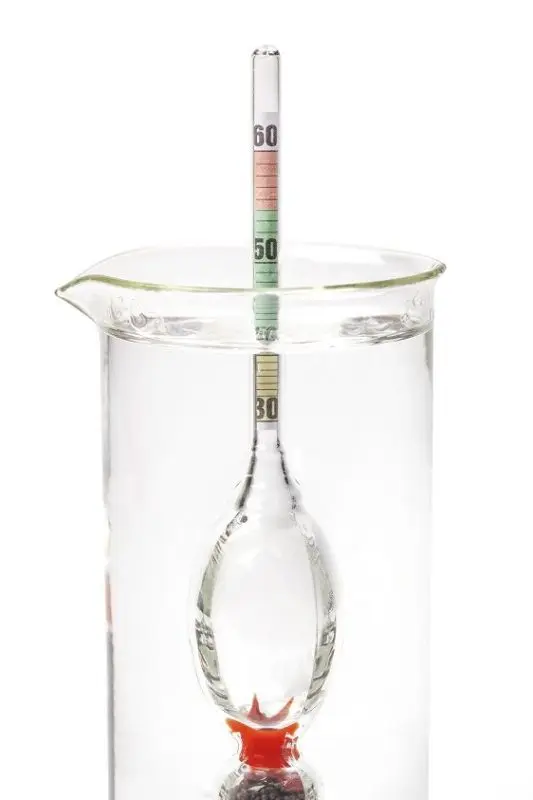Fortress – the content of anhydrous (pure) ethyl alcohol in an alcoholic beverage. The concentration of alcohol can be calculated by two methods – by mass and by volume, but since the mass of the liquid is not equal to its volume, the results will be different. This causes confusion among consumers, and different designations on the labels further exacerbate the situation. Depending on the country and manufacturer, the fortress can be expressed in degrees (°), percent (%) and proof.
In Russia, since the times of the USSR, degrees have traditionally been used to indicate the concentration of alcohol by mass. In this case, a degree is one hundredth (0,01) of anhydrous (100%) alcohol, which weighs 7,94 grams. The bottle label contains a number with a small circle, such as 40° or 45°. This is the most accurate metric, but in the 70s of the XX century, when the export of vodka to capitalist countries began, in the USSR, along with the domestic system, they began to use Western marking of the fortress – in percent. The problem is that the percentages themselves can be calculated both by volume and by mass, therefore, without additional indication of the method of calculation, they do not make sense. The disadvantage of measuring by volume is that it does not take into account differences in the weight of water, alcohol and other substances in the composition of the drink, and the degree of purification of alcohol is also not taken into account.
In the generally accepted international system, the strength of alcoholic beverages is indicated as a percentage of the volume and is labeled with the inscription (% vol.), From the English “volume” – volume. An alternative notation is % ABV (Alcohol by volume). Russian manufacturers for the domestic market use the marking (% vol.), which is popularly called “turns”, although in fact “vol.” obtained by abbreviation of the word “volume”. This means that (% vol.), (% ABV) and (% vol.) express the same strength, but differ from degrees (°). For example, 40% vol. = 40% ABV = 40% vol. ≠40°.
The fortress in degrees is greater (the concentration of ethyl alcohol is higher) than the fortress in percent by volume. If 1 liter of vodka 40 ° contains 572 g of water and 381 g of alcohol, then in a similar amount of vodka 40% vol. there will be 635 g of water and 318 g, which corresponds to about 35 °.
There is no universal formula for converting volume fractions into weight fractions that could be applied to all alcoholic beverages, since, in addition to water and alcohol, other substances in the composition must be taken into account: sugar, acids, tannins, fusel oils, etc., and their concentration is always different.
However, only experienced tasters can feel the difference in strength of 1-4 degrees, therefore consumers often do not pay attention to different strength designations, believing that all markings are the same.
In the Russian Empire, before the invention of the hydrometer (a device for determining the concentration of alcohol in an aqueous solution), the strength of alcoholic beverages was measured by ignition – the tested alcohol was poured into a special measuring ladle, set on fire and waited for the flame to go out. Then looked at the volume of the remaining liquid. If about half burned out, then the drink passed the test.

In America and Britain, they used a faster way to check quality. In the Wild West, sellers soaked gunpowder with alcohol and set it on fire. If the mixture ignited, the high strength of the drink was considered proven – proof (translated from English as “proof”). The approximate strength of alcohol at which gunpowder ignites is 50% vol., and on the American scale it is equal to 100 proof (“proof”), that is, one hundred percent proof of quality.
The same method was used by sailors of the British Navy when they checked whether their legal portion of rum was not too heavily diluted with water. However, the “British proof” (Br. proof) is equal to 57% vol., since not pure, but diluted alcohol is taken into account, and instead of a liter, a gallon is taken per volume unit. A coefficient of 1,75 was used to convert British Proof into volume percentages. This means that 40% vol. = 70 Br. proof (40 × 1,75 = 70). In 1980, Britain switched to indicating the strength of alcohol by volume, joining all other European countries, and Br. proof has become history.
Modern proof (alcohol proof, proof spirit) is a measure of the strength of drinks, which is equal to twice the alcohol content in the volume of liquid. This means that 80 proof = 40% vol. = 40% vol. To get the “turnovers” familiar to a Russian-speaking person, it is enough to divide the “proof” into two.
Basically, proof is used by manufacturers from the USA, paying tribute to traditions. However, on all bottles of American spirits that are exported, along with “proofs”, “turnovers” (% vol.) are necessarily indicated, since this is the international standard. The ABV marking can be found on foreign beer, often it is also duplicated by volume percentages.









